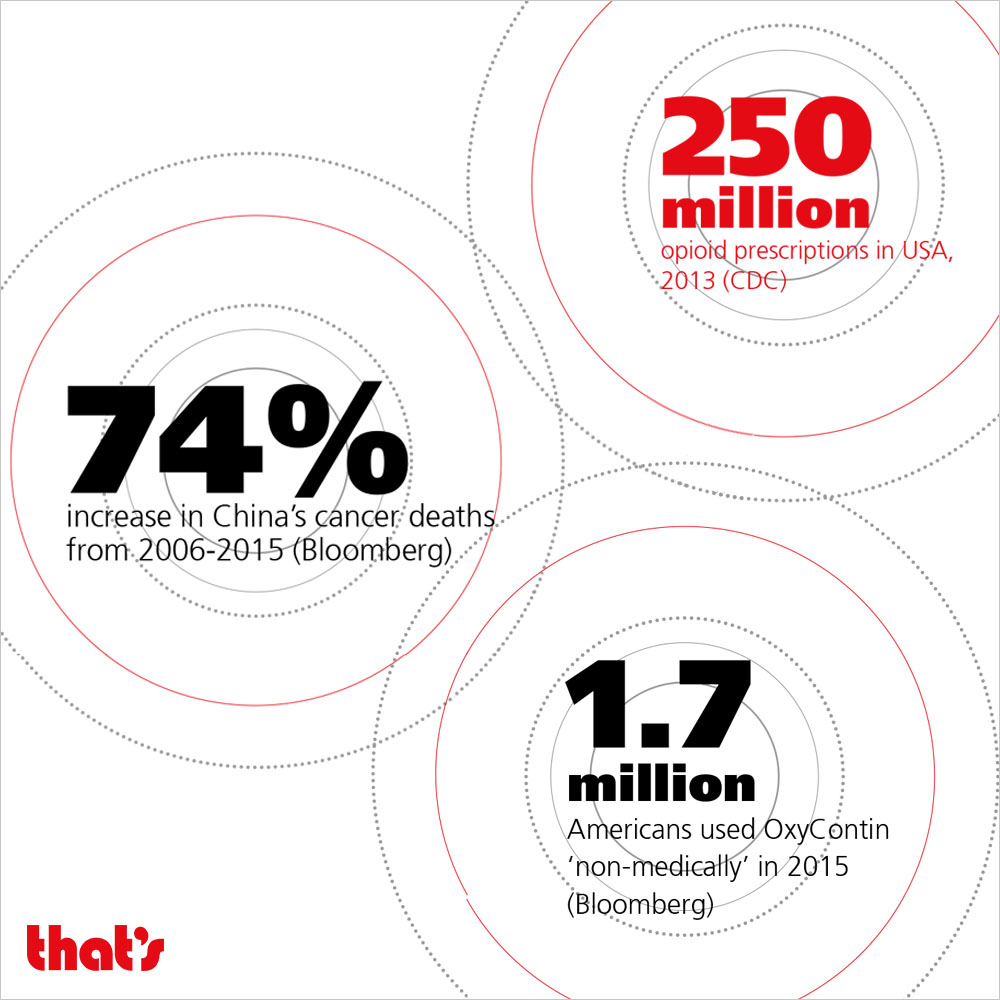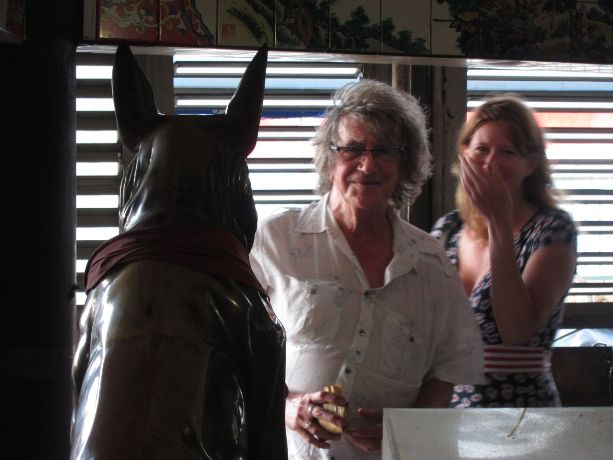This is part of our 'Pain Treatment in China' series.
It might have been stamped out during the Communist Party's efforts in the 20th century, but China's history with opium use still characterizes its attitudes towards pain relief to this day. Despite having been used socially among China's elite idle rich since the Tang dynasty, by the early 1900s nearly 25 percent of the working male population were using opium, following defeat by British forces over the importation of the substance.
For both international observers and the Chinese, the apparent loss of productivity, business activity and an uptick in corruption within the civil service brought on by opium addiction crystalized the idea that narcotics had the capacity to cripple entire societies, leaving them vulnerable to foreign manipulation and economic ruin.
Today, an opioid addiction epidemic has unfolded in the United States. The CDC (Center for Disease Control and Prevention) has described it as "the worst drug epidemic in US history," claiming over 200,000 lives from overdoses. But this time, the drug that kick started the epidemic is a legal painkiller prescribed by doctors: OxyContin.
A backlash from doctors and scrutiny from regulators has forced its manufacturer, Purdue Pharma, a company privately held by the billionaire Sackler family, to seek new horizons; up-tapped markets where OxyContin's success might be replicated with the same terrifying efficiency achieved in America. China offers one of the most lucrative expansion opportunities, with the company posted profits of USD100 million in 2015. But can the same strategy work in a country already bearing the scars of opioid abuse?
"For Chinese, Opium is a Big Word"
Anti-opium campaigns had existed before the Communist Party took control in 1949, but the Party's drastic methods to remove the "scourge of opium" cemented attitudes towards their use. Harsh anti-narcotic laws and limits on prescription, aimed at preventing the spread of non-pain related opioid use in society, have also contributed to a lack of pain management options.
Doctors sense a prevailing stigma towards opioid analgesics from patients too. "The Chinese are very concerned about opium. Opium is a big word," notes Dr Anne Lee, a clinical professor at the University of Hong Kong. Fear of addiction is so strong that even post-surgical patients refuse basic opioid analgesics like morphine, according to Dr Cheung Chi-wai, president of the Society of Anesthetists, adding that sensitive memories of China's battle against opium deters patients from accepting relief.
READ MORE: China's Maritime Dope Slingers, Explained
China's consumption of opioids pales in comparison to the United States, at a startling comparison of approximately 7 ME (Opioid Consumption in Morphine Equivalence, mg per person) among the Chinese versus 677.7 ME for Americans in 2015, figures that suggest a sizeable portion of patients aren't receiving adequate pain relief.
The numbers don't look good from a pharmaceutical company's perspective, but China's soaring cancer rates have ushered in new attitudes and policies towards treating pain, and new opportunities for the companies who exploit them.
"Heroin Pills"
Andrew Kolodny is a medical doctor and Co-Director of Opioid Policy Research at the Heller School for Social Policy and Management at Brandeis University. He's one of the world's foremost experts on opioid rehabilitation, and one of the most vocal advocates for cautious prescribing of opioid painkillers. "The effects that opioid pain relief medication like OxyContin and and Oxycodone produce on the brain are indistinguishable from the effects produced by heroin. We are essentially talking about heroin pills."
"When we talk about opioid painkillers, we are essentially talking about heroin pills."
— Dr Andrew Kolodny, Co-Director of Opioid Policy Research at the Heller School for Social Policy and Management at Brandeis University
"This doesn't mean we should never prescribe them," he continues. "These are very important medicines for easing suffering at the end of life, or when used on a short-term basis. Unfortunately, the bulk of consumption of US-based opioids [have not been] for end-of-life nor short-term prescription."
Overcoming Opiophobia

Opioid analgesics like morphine have been used to treat pain for decades, so why did the launch of OxyContin result in an addiction outbreak? Part of the reason can be attributed to its claim of a 12-hour extended-release system, a mechanism which Purdue sought an FDA-issued patent for, asserting that it minimized the chance of addiction.
In 2007, Purdue and three of its executives pleaded guilty in a federal court of misleading doctors, patients and regulators over the addiction risk of OxyContin, and were ordered to pay a fine of USD634 million. A lot, perhaps, but just a drop in the USD31 billion ocean that the company has accrued from the sale of the drug. So much revenue that the Sackler family, who own Purdue Pharma, debuted on Forbes 2015 list of America's richest families with an estimated net worth of USD14 billion.
READ MORE: 10 Chinese Schools Found to Have Fed Kids Illegal Prescription Meds
OxyContin is still approved by the FDA for long-term use, something that Kolodny argues is incompatible with sustainable treatment. "The trouble with opioids for chronic pain isn't just that they're addictive, dangerous and have pretty bad side effects, the problem is that they don't work. What happens after as little as one week is that the patient becomes tolerant and needs higher doses. Finally, you get to a point where instead of the opioid giving pain relief you get a phenomenon called hypoalgesia, where you actually become more sensitive to pain."
Studies by Bradley Martin, a professor of pharmaceutical evaluation and policy at the University of Arkansas for Medical Science have shown that in patients who took opioids for 10 continuous days, one in five were still on an opioid drug years later. Kolodny adds that this study examined only immediate release opioids, "For extended release opioids like OxyContin, those statistics are even higher."
A Pattern of Addiction

By 2009, emergency room visits related to prescription drugs reached 1.2 million cases, with OxyContin attributed as the leading cause for visits and fatalities. An investigation by the LA Times found that when faced with withdrawal, users turned to illegal or black market sources to maintain their supply. The report found a phenomenon of non-prescribed users crushing the pills into a powder to snort, smoke or inject to bypass the extended release system, delivering intense and immediate relief from withdrawal.
Subsequent "abuse-deterrent" reformulations of the drug have reportedly done little to quell abuse. A study at the Washington University School of Medicine in St. Louis, Missouri found that a third of users were able to sidestep the mechanism, while the National Bureau of Economic Research found that others turned to heroin, resulting in a spike of heroin overdose fatalities.
READ MORE: Did Counterfeit Pills from China Kill Prince?
Reports of America's addiction epidemic have caused a decrease in sales of OxyContin. According to Forbes, prescriptions have declined at a rate estimated to be at around 17 percent last year, down 40 percent since 2010. As such, Purdue Pharma realized that the time was nigh to start thinking outside the US.
China's Changing Attitudes
As recently as February 2017, the Chinese Ministry of Human Resources and Social Security expanded its list of Western medicines reimbursable by public health insurance schemes for the first time in eight years from 133 to 1,297. It signalled a new era of affordable Western medication and more frequent prescription.
Mundipharma, an associated company of Purdue Pharma that manufactures OxyContin in China, has already capitalized on the evolving nature of state medical care, which emphasizes a standardized approach to care that could offer pharmaceutical companies a lucrative near monopoly state on certain medicines. OxyContin, which has been available in China for many years, currently enjoys a 60 percent market of cancer-related pain relief according to Greater China General Manager Wang Zhongling, in an interview on Mundipharma's website.
The rules for prescribing opioids in China are more stringent than in the US. In non-cancer patients, they must have been in pain for at least four weeks, be over the age of 40 and have tried alternative pain management methods. Additionally, they are only permitted a seven-day supply (up to 15 for cancer patients) according to the global NGO Human Rights Watch.
Dr Ivan Lau, a Family Physician at the Jiahui Clinics in Shanghai, notes that doctors have jurisdiction to repeat a patientís seven-day prescription "dependent on follow-up clinical assessment."
"The doctor may also consider adjusting the dosing," he adds, confirming that China's regulatory framework allows leeway for doctor discretion on individual cases, underscoring the significant influence that holding training seminars for medical professionals can have.
"I've treated patients who've beaten cancer and wound up addicted to opioids."
— Dr Andrew Kolodny, Co-Director of Opioid Policy Research at the Heller School for Social Policy and Management at Brandeis University
Still, Andrew Kolodny argues that these guidelines allow too much margin for addiction. "Even the 'perfect' pain patient will start to need higher doses to get pain relief, just as they will have cravings when they try and come off. If they stay on OxyContin for a few months, many may never be able to come off. For particularly painful surgeries, an opioid wonít be needed for more than seven days."
The interview with Mundipharma's general manager goes on to state that the company's focus will be toward palliative care for late-stage cancer patients, though Wang also endorses OxyContin's potential for non-late-stage cancer sufferers "to help patients establish confidence" — something Kolodny says also poses a risk. "Many people with cancer now survive it. If you use opioids aggressively on somebody with a curable cancer, they can be left with an opioid addiction that can devastate their lives. I've treated patients who've beaten cancer and wound up addicted to opioids."
"Secondly, even with cancer that is unlikely to be cured, you need to be cautious with opioids early on because if you're too aggressive in the beginning, the patient will need astronomically high doses in order to get pain relief at the end. If, in the course of their cancer they need surgical care or medical intervention that is painful, as the doses escalate it becomes very difficult to treat their pain, meaning they can have more suffering at the end."
Same Tactics, New Country?

China's low consumption of opioids suggests widespread under-prescription for palliative care and major post-surgery patients, a problem that the government has made a concerted effort to resolve by increasing access to opioid analgesics.
Training sessions designed to educate doctors on the safe administration of pain management are another method to influence doctors. Mundipharma has been involved with government bodies in China since 2011, when it assisted the health ministry and Chinese Society of Clinical Oncology with an initiative called the "Good Pain Management Programme."
A Bloomberg reporter has alleged that materials used during an educational seminar training session in eastern Zhejiang province cited decades-old studies and letters (Jane Porter, Hershel Jick, New England Journal of Medicine, 1980) stating that opioids have addiction risks of just 0.6 percent, a statistic that was used on doctors in Purdue's training seminars in the 1990s. The presentation also highlighted OxyContin as a "global bestseller" with few side effects, thereafter devoting several slides to the "shortcomings of rival therapies."
Virtually identical content was seen at a similar conference in Beijing, and again in a patient manual posted to the Mundipharma website. Mundipharma claims that such presentation materials were prepared by the speakers outside of its involvement, and the patient manual was published by the Chinese Society of Clinical Oncology.
READ MORE: Kindergarten Gave Students Risky Prescription Meds without Informing Parents
"I would imagine the message that drug companies are putting across is that because of China's history with opium there's been an overblown fear of opium-based drugs, and that patients have been subsequently suffering without adequate pain management," argues Kolodny, who says that the US "opioid lobbyists" have attempted to pin the opioid addiction epidemic on "drug abusers," suggesting that if opioids are prescribed medically, the risk of addiction is low. "I'm not really sure why China even needs Oxycodone (the generic opiate in OxyContin) at all if they already have morphine available."
Evidence may also suggest some within China's medical community harbor misconceptions of prescription opioids that pre-date the American addiction epidemic. "Clinical observations show that pain itself is capable of putting up the most powerful defense against any potential addiction," says Xu Guozhu, former director of Peking University's National Institute on Drug Dependence in a February 2013 China Daily article. "In other words, patients who take morphine for pain relief are much less likely to get hooked than those who do so recreationally, for fun."
"That's totally not true," Kolodny refutes. "If you're using an opioid repeatedly, whether you're smoking opium, taking pills recreationally or because a doctor prescribed them to you, the use of this highly addictive drug causes structural changes in the brain."
"Furthermore, many doctors also don't realize that Oxycodone and OxyContin are chemically more similar to heroin than morphine is to heroin, something that drug companies have also exploited."
A Warning Message
"I think it's really important that China learns from our mistakes," says Kolodny. He's backed up by a letter from 12 US Congressional Representatives sent to the World Health Organization's Director General on May 3, 2017, urging caution against the spread of OxyContin into other countries. "The greed and recklessness of one company and its partners helped spark a public health crisis in the United States that will take generations to fully repair," it reads.
Citing the Sackler family by name, the letter issues a bleak warning that describes the troubling similarity between "training seminars" given abroad and those in America during the mid-90s. "The international medical community has a rare opportunity to see the future," it continues. "We urge the WHO to learn from our experience and reign in this reckless and dangerous behavior while there is still time."
See more stories in our 'Pain Treatment in China' series.






















0 User Comments